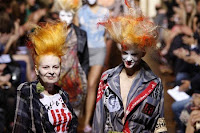forged a reputation as fashion’s provocateur by taking proverbial shears to the sartorial proprieties of her time. An aesthetic trailblazer whose fiery red hair is a match for her temperament, she is widely regarded as the most influential British designer of the last quarter century.Born in Glossop in Derbyshire in 1941, Ms. Westwood studied art and taught elementary school in North London before embarking on a fashion career. By the early 1970s, she had joined with the British rock impresario Malcolm McLaren to fashion an image for British punk culture, channeling her fascination with the subcultures of sadomasochism and fetishism into the clothing she designed and sold at Let It Rock, Mr. McLaren’s store on Kings Road.
 A bastion of subversiveness in its day, the shop underwent several transformations. Under the name Sex, and then Seditionaries, it was the first authentic punk boutique, selling the bondage gear and shredded T-shirts that became punk’s visual insignia. By the mid-70s, Ms. Westwood was fusing rock’s renegade spirit with the sexually aggressive fashions of her Bondage collection. With Mr. McLaren, she created the look of bands like the Sex Pistols and the Clash, which incorporated raw, street-inflected features like zippers, studs, razor blades, toilet chains, safety pins and spiked dog collars worn as chokers.
A bastion of subversiveness in its day, the shop underwent several transformations. Under the name Sex, and then Seditionaries, it was the first authentic punk boutique, selling the bondage gear and shredded T-shirts that became punk’s visual insignia. By the mid-70s, Ms. Westwood was fusing rock’s renegade spirit with the sexually aggressive fashions of her Bondage collection. With Mr. McLaren, she created the look of bands like the Sex Pistols and the Clash, which incorporated raw, street-inflected features like zippers, studs, razor blades, toilet chains, safety pins and spiked dog collars worn as chokers.
 A succession of themed collections including Pirates and New Romantics influenced a younger generation of performers like Bow Wow Wow and Adam Ant. Throughout the 1980s, her work was informed by period influences, among them the luxurious ornamentation of Marie Antoinette’s Petit Trianon; the costumes and pageantry of the Elizabethan court; Victorian corsets and crinolines; and Scottish tartans. By the end of the decade, her signature blend of hard-edged sexuality and effusive historicism confirmed her as a leader of the international vanguard.
A succession of themed collections including Pirates and New Romantics influenced a younger generation of performers like Bow Wow Wow and Adam Ant. Throughout the 1980s, her work was informed by period influences, among them the luxurious ornamentation of Marie Antoinette’s Petit Trianon; the costumes and pageantry of the Elizabethan court; Victorian corsets and crinolines; and Scottish tartans. By the end of the decade, her signature blend of hard-edged sexuality and effusive historicism confirmed her as a leader of the international vanguard. Ms. Westwood has been hailed as a "designer’s designer" by John Fairchild, the powerful former editor of Women’s Wear Daily. Yet her subversive concepts, elements of which have been seen in collections as diverse as those of Jean Paul Gaultier and Comme des Garçons, ultimately found their way into the mainstream. In the mid-80s, her mini-crinolines inspired a shift in fashion’s silhouette, spawning the widely imitated pouf skirts that came to symbolize the excesses of the day.In 2004, a retrospective of her work was shown at the Victoria and Albert Museum in London. In 2006, she was named Dame of the British Empire, for "services to British fashion."
Ms. Westwood has been hailed as a "designer’s designer" by John Fairchild, the powerful former editor of Women’s Wear Daily. Yet her subversive concepts, elements of which have been seen in collections as diverse as those of Jean Paul Gaultier and Comme des Garçons, ultimately found their way into the mainstream. In the mid-80s, her mini-crinolines inspired a shift in fashion’s silhouette, spawning the widely imitated pouf skirts that came to symbolize the excesses of the day.In 2004, a retrospective of her work was shown at the Victoria and Albert Museum in London. In 2006, she was named Dame of the British Empire, for "services to British fashion."
 A political activist throughout her career, she joined with the British civil rights group Liberty in 2005 and introduced limited-edition T-shirts bearing the slogan “I’m not a terrorist. Please don’t arrest me.”In true rebel fashion, she once said of her work, “My aim is to make the poor look rich and the rich look poor.”What is genuinely amazing is that she has remained outside the official core of fashion, which to many insiders has become sick and narrow-minded, and by doing so she seems more real, more interesting.She keeps insisting in interviews that she doesn’t like to talk about fashion, but the fact is that this highly intuitive, slightly dotty, self-trained genius is, again, making clothes that people want.
A political activist throughout her career, she joined with the British civil rights group Liberty in 2005 and introduced limited-edition T-shirts bearing the slogan “I’m not a terrorist. Please don’t arrest me.”In true rebel fashion, she once said of her work, “My aim is to make the poor look rich and the rich look poor.”What is genuinely amazing is that she has remained outside the official core of fashion, which to many insiders has become sick and narrow-minded, and by doing so she seems more real, more interesting.She keeps insisting in interviews that she doesn’t like to talk about fashion, but the fact is that this highly intuitive, slightly dotty, self-trained genius is, again, making clothes that people want.




No comments:
Post a Comment